Denisa Rahma
The transition from photography to 3D art has reshaped Denisa Rahma’s creative perspective. In photography, she often felt limited by specific locations, props, or ideal conditions, but 3D frees her from those constraints. Recently diving into Blender, she’s found a fresh outlet for her creativity, exploring a medium that offers precision and control that photography couldn’t provide. While she still values photography, 3D opens a complementary freedom, allowing her vision to emerge exactly as imagined—where the tangible and the limitless coexist.
How did the shift from photography to 3D art reshape your creative expression?
I've often felt constrained by the limitations of photography, where access to specific locations or the perfect props wasn't always feasible. With 3D, however, there's a freedom to build entire worlds without the challenges of travel or sourcing materials. I've been learning Blender for a few months, it’s an entirely different realm compared to photography. I still take photos, but 3D allows me to achieve the exact imagery I envision.
What aspects of sci-fi, brutalism, and mysticism draw you into their visual worlds?
Being raised in a Muslim family in Indonesia, I was naturally exposed to mystical and spiritual concepts from a young age. Having had several inexplicable experiences back home, I’ve come to believe in the existence of entities beyond our understanding. These experiences have influenced my creative approach. Additionally, I grew up watching a lot of Anime and developed a love for sci-fi films. I'm also drawn to brutalist and liminal spaces—the eerie, minimal, desolate beauty of such environments resonates with me, as a photographer I had to socialize and network often, but my social battery is pretty low, so I find solace looking at empty and forlorn spaces.
How do you approach mixing personal identity with broader themes in your 3D work?
I get fully immersed in experiences that often inspire my art through a personal lens. Much of my work is an exaggerated reflection of the ordinary moments I encounter in daily life, or TV shows I watch. I frequently draw inspiration from experiences of others as well. It’s almost like a form of role-playing.
What excites you most about the interplay between technology and artistic freedom?
I'm both excited and anxious about the influence of advancing technology on art. The accessibility of tools and resources today far surpasses what was available in the past. I’m particularly struck by how machine learning replicates man-made art. With all this new softwares i have yet to recognize and learn, it's easy to get overwhelmed. But we often overlook that even the most advanced technologies are still part of nature, and this is a natural cycle. I wouldn't be able to create what I do—whether through photography or 3D—without access to technology in the first place. So I’ve come to embrace it rather than resist, to focus on how it can elevate my own artistic practice, and so far the possibilities seem endless, I'd love to see how they evolve in the next few years.
Can you share the most challenging aspect of transitioning from photography to 3D?
The biggest challenge I face is definitely being an amateur and starting from zero. Geometry nodes, for instance, makes me feel like I am learning algebra all over again. Unlike photography, where imperfections are bound to be shown - the 3D geometries are so precise, it results in compositions that appear overly perfect for my preference, and I spend more time trying to make them look imperfect and wonky instead, when I can't get the results I'm picturing, I use photoshop for added elements, color grading and illustrations.
How do you see your work evolving as you continue to explore new mediums?
I would love to explore more motion, new media and maybe get into VJing. Definitely anything that involves collaborating with my favorite music artists. I'm also always in awe of creative technologists and hope to become one someday.
Interview by DONALD GJOKA
What to read next

















